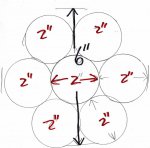You got some good ideas man. I think the diffuser plate, as ya describe it as a "top turn" plate, would be an awesome addition to make a better settlement chamber.
The problem with the raised short walls of the baffle is that it is going to get filled up with debris but the entering water turbulence might just flush out any debris that might get trapped in it. I'd be up to trying it.
Yeah, I was wondering about if a convex plate would properly reduce the turbulence or if it would simply just displace it.
Rather than the convex plate, substitute it with a sharply angled concave plate with a cone glued below it. I'm actually liking your idea better.
For folk who may or may not know...
There are many variations of settlement chambers in an effort to find that "better" settlement chamber. The typical minimum size, that is completely dependent on the flow rate, of a basic settlement chamber is around 160gallons and all the way up to 1,200 gallons, which is crazy for just a large particulate filter. This is due to the fact of what it takes to reduce the water's velocity and the velocity is what is attempted to being addressed in a
radial flow settlement chamber. So, there have been variations made such as
VMS settlement chambers (like the
Answer, which isn't made anymore),
vortex settlement chambers with brushes or a
vortex with a pre-filter. There have been all sorts of
settlement chambers variations.
Personally, I am not a big fan at all of settlement chambers, except for I do like how they are simple and cheap to build. I think settlement chambers is old school technology that is being quickly replaced by sieves, which sieves unfortunately are a bit more expensive to DIY due to all of the extra material and plumbing. Here's the best
DIY sock filter sieve that I have seen. Supposedly, the going rumor is that sieves are supposed to be "self cleaning", but I think this is just marketing hype since all of the sieve builds I have seen require assistance in removing the debris without losing quite a bit of water. The
RDFs are the only truely self cleaning particulate filters, but they still dump quite a bit of water from the system's cleaning of the sieve screen.
A quick aside... Rocks should never be cleaned out of a
properly built and
pre-filtered S&G filter. I know folk that go on for 3~5 years before ever dismantling them, that is if they do it, since it is not necessary at all. These S&G filters are polishing filters so they would have to be properly pre-filtered to remove large particulates out of the water prior to entering the S&G. Although, I have seen them used as a large particultate filter, which I do not recommend due to clogging. S&Gs should be properly blown out every 3~5 days, which only takes a flip of a switch, opening the waste outlet, and around 5 minutes. S&Gs are not settlement chambers, they are polishing filters and a side effect is it also does some bio-filtering. I know there are concerns of obligate anaerobic zones forming, but, if the S&G is properly blown, then this is of no concern. S&Gs can be of any size, that is even a 5 gallon bucket, but the depth of the rock layers and size of the container will determine the filter's flow rate and the blower's strength.
I would go so far to say that S&Gs are better than the cheap bead filters due to the fact that bead filters require a stronger water pump to properly operate them. S&G's don't need a strong pump. I even know a
guy that has replaced his expensive bead filters with S&G filters and have obtained much better results for his pond. Of course though, S&G's do have a bigger space foot print. I have also seen a fella build a 200 gallon S&G, but he was using one really big blower that was tied off to supply the multiple diffusers at the bottom.
S&G's are essentially bogs, can put some floating plants on top of the S&G, except far better than a bog since they are not a ticking time bomb like a bog can sometimes become over time.
Talking mechanical filtration is quite fun and tossing around that idea football quite fun as well. I think it is neat how quilt batting is used so much on this forum since it does work and it is cheap.






